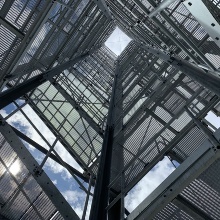On November 26th, 2020, the German Research Foundation (DFG) approved the extension of the Collaborative Research Center (CRC/SFB) 1244 "Adaptive skins and structures for the built environment of tomorrow" at the University of Stuttgart. Over the next four years, SFB 1244 will demonstrate further possibilities of how adaptive architecture can be used to create more living space with less material without emissions. Currently, members of the faculty are the spokespersons for two collaborative research centers.
In the second funding period Prof. Werner Sobek (Institute for Lightweight Structures and Conceptual Design ILEK of the Faculty) will hand over the tasks of the speaker to Prof. Sawodny. He emphasizes: "In the first funding period, we were able to prove that our working hypothesis is correct: with the help of adaptive shells and structures, we can achieve drastic savings in waste, resources and emissions for the construction industry. The extension of the project underlines the recognition of the global social importance of our work".
Building as challenge and an opportunity
Construction is currently responsible for more than 50 percent of global resource consumption. The current construction volume of more than 1,000 tons per second is leading to bottlenecks in the supply of materials in more and more countries - a well-known example of this is the shortage of sand needed for concrete production. In addition, the construction industry accounts for almost 40 percent of climate-damaging emissions. The production of concrete alone causes almost three times as many greenhouse gas emissions as global aviation.
With a growing world population, the need for housing will continue to increase in the coming years, so that the construction industry is the source of even the most pressing environmental and social challenges of our time.Over the past four years, SFB 1244 has been able to demonstrate that adaptive elements can save considerable amounts of building materials and the associated grey energy and grey emissions. Such elements make it possible to specifically modify the structural and building physics properties of materials and building components so that they always adapt optimally to different loads. In this way, load-bearing structures can be produced with less material and energy input.

First adaptive high-rise in the world at the center of the work
The results of the first funding period were incorporated into the construction of the world's first adaptive high-rise building. Over the next four years, "The high-rise with muscles" will continue to serve the researchers as a large-scale experiment to show that adaptive facades and flat components can further increase the contribution to material and emission savings in the building industry. The novel structures and facades can adapt to external influences in a self-regulating manner in order to make intelligent use of energy and mass. This type of adaptive architecture also revolutionizes the architectural-theoretical understanding of what we consider a building. The focus of research is thus also the revision of the idea of the building as a finished product to a constantly adapting construction that acts as a mediator between man and his environment.
Showing solutions together
n addition to three institutes of the faculty, eleven other institutes from other faculties as well as other universities and non-university research institutes such as the Fraunhofer Institute for Building Physics are involved. The research association thus comprises 23 sub-projects with over 50 researchers. It is funded by the German Research Foundation with over 10 million euros for the next four years.
The researchers will continue to make their knowledge and findings available to the public. The demonstrator high-rise will be made accessible in guided tours and is also part of the 2027 International Building Exhibition. SFB 1244 also invites interested citizens to attend lectures and symposia.


